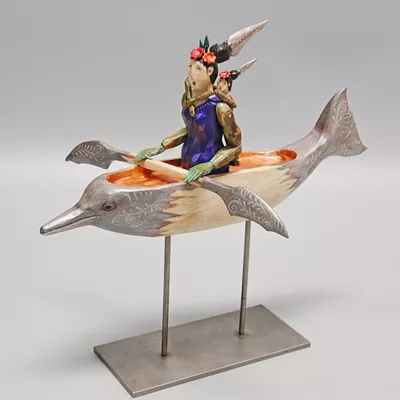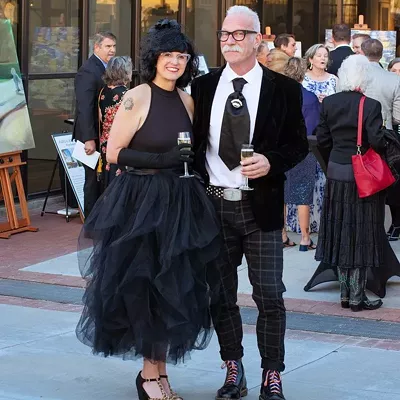Tucson has a lot going for it—transcendent lighting, relative affordability, perfect refried beans, Rococo clouds. The list goes on, but an arts community full of raw talent and a lack of pretention is right near the top of it. Of those many attributes, Christian Ramirez, Director of Education and Performance at Tucson's Museum of Contemporary Art (MOCA) is perfectly suited to represent those strengths. She is welcoming and inclusive, with an eye for talent and the desire to see that talent shine.
MOCA's mission is "to inspire new ways of thinking through the cultivation, interpretation and exhibition of the cutting-edge art of our time." For Ramirez, furthering that mission is largely about creating points of entry for different demographics.
The museum has a small staff, so she is quick to note that many of her efforts are collaborative. "We all help each other with what we want to get done," she says. "That's how a healthy community works. You need each other to succeed. You can't do anything by yourself, and you need relationships with your peers and the larger community."
The museum, with help from The Robert Barber Fund for Children's Creativity, is able to offer myriad youth programs, providing free tours and even subsidizing transportation for students. "With the RBFCC, we've been able to make all our youth education free. This includes after school programs and summer camp," she says.
By providing free youth art education, MOCA is able to welcome children who might otherwise have never stepped into their building—or any museum for that matter. Once they're in the door, it's not hard to convince them that a museum isn't a scary place.
"It's so awesome to see families come back upon the request of the child after they've been through one of our programs. It's a little indicator that we're on the right track," Ramirez says.
Many adults also seek a soft entry to the world of contemporary art, and MOCA is providing them unique options to get through the museum doors. MOCA offers Yoga classes and Cardio Party-o! (both are free for MOCA members), as well as artist talks and exhibition openings.
Perhaps the most exciting and engaging draw is Ramirez' integration of live music into MOCA's programming. So far the live music offerings have been a huge success for the nonprofit museum. Attendance numbers are higher than ever, and often attendees sign up for memberships.
Booking live music isn't just about increasing attendance, though. Ramirez views music as a huge part of Tucson's art community. As a converted fire station, MOCA's great hall once housed nine or ten trucks. It's huge, but it also sounds like a cave.
"It has a unique soundscape, so the people who play there need to embrace it because it's not a traditional venue space," says Ramirez.
Over the summer MOCA had local young punkers Get a Grip play at Pat Foley's pop-up shop. "It was the only time I've seen a mosh pit in a museum. It was a moment of 'oh boy,' but then I realized it was perfect," she says.
In turn, the band brought a whole new demographic to the museum. Many in the young crowd became members so they could go swimming (the show took place during the "Mobile Pools" exhibit), and Ramirez says she has seen several of them return over the last few months—a sign of the programming's success.
"Contemporary art is not necessarily the easiest thing to wrap your mind around, but music is such a guttural thing—you feel it," she says. "I want to try to use that as a way to incorporate it into the rest of contemporary art."
Her goal is to get people into the museum and make them feel comfortable, and music is a good way to do that. Of her accomplishments in bringing the community into MOCA, one of her proudest programming moments was "Silence and Noise," an evening of experimental electronic music meant to embrace the reverb and tonality of the MOCA's great hall. Ramirez is a big fan of experimental and noise music, and she was touched to see 150 people come out on a Tuesday night to listen to it.
In April, MOCA will host "Beats In C," local musician Lasso's take on the artist Terry Riley's minimalist composition "In C." The piece consists of fifty-three short phrases, and Lasso is in the process of creating beats for each phrase, blending the worlds of hip-hop and electronic music with modern classical compositions.
Facilitating collaboration is one of Ramirez's greatest strengths and connecting with the community personally is a big part of that. When Ramirez finds out about an artist that she thinks would work well with another artist, she quickly makes an introduction.
"I feel really lucky that that is my job—to find something that's already happening and be like, 'hey, let's do something.'" The Tucson community, which benefits from Ramirez's work as an artistic junction, should feel really lucky too.
For more information on programming, or to become a MOCA member, visit www.moca-tucson.org. Memberships start at only $4 a month, and MOCA offers a list of member perks too long to print here.
By becoming a member, you not only support the arts in your own small financial way, you help make a statement about the degree to which Tucson values the museum.







